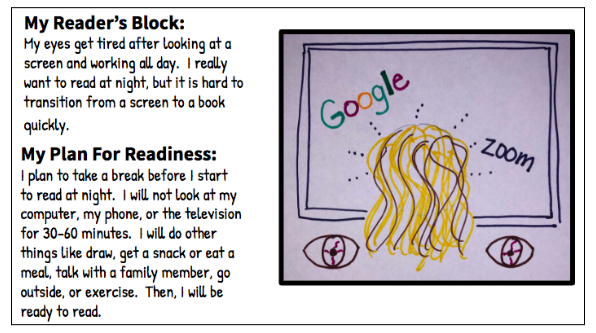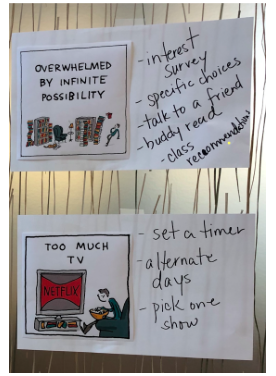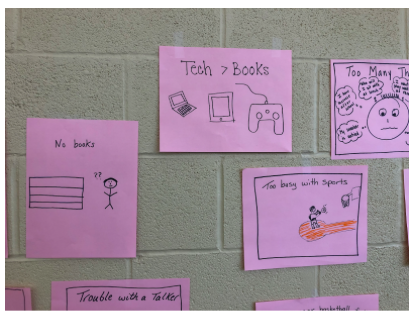Guiding Students to Design Personal Plans for Reading and Learning
This post is about reading engagement and building a reading community. You will find:
A lesson to engage students in practicing planning skills to make time for reading in school and/or at home. The lesson can also apply to making personal plans for learning and completing assignments.
A link to a graphic article to use to invite students into a discussion about designing personal plans for reading.
Images of sample work to help with planning.
I didn’t read last night because:
I had hockey practice.
I forgot my book in school.
I left my book in my dad’s car over the weekend and I’m with my mom on Monday nights.
I fell asleep.
I had to take care of my brother and sister.
I had other homework to do.
I don’t like my book.
I finished my book and I didn’t have another one.
My book is boring.
I had a party to go to.
It was too loud in my house.
I was tired from the school day.
I had a rehearsal last night.
I love my book so much that I don’t want it to end…so I stopped reading.
My mom couldn’t read with me.
It’s just too hard.
I couldn’t concentrate.
I don’t have a place to read.
Do any of these statements sound familiar? These are reasons why some of my students did not read at home or in school at various times throughout the year. I was so appreciative when they shared these reasons with me.
Honesty and trust were values within our reading community: I counted on my students to be honest with me about their reading habits and routines, and my students trusted that my responses to their honesty would never be punitive, only supportive. By identifying what made making time for reading challenging, I was able to teach my students ways to organize personal reading plans, strategies for time management, and to be reflective on the factors that influenced their productivity as a learner. For some, managing several responsibilities begins at a young age.
Planning, organizing, time management, and reflection are skills that transcend reading. As a literacy teacher, I was able to guide my students through these processes in the context of making time for reading, but the skills are applicable to a variety of learning experiences in both academic and personal spaces. They are skills that students should hone in each grade-level through age-appropriate experiences to help them exercise agency and practice feelings of self-efficacy.
According to the Future of Jobs Report (2023) by the World Economic Forum, three of the top five core skills workers need in 2023 are self-efficacy practices: 1) resilience, flexibility and agility, 2) motivation and self-awareness, and 3) curiosity and lifelong learning. These core skills are prioritized in future organizational development industries like Research, Design, and Business Management services, Medical and Health Services, and the Electronics Industry. Students can begin to develop these skills by creating and maintaining manageable reading lives that suit them. Reading lives vary. They are different. Embrace the teaching opportunity!
There is a great graphic article by Grant Snider in the New York Times titled We All Know About Writer’s Block. What About Reader’s Block? Snider mixes humor with reality to illustrate reasons why people may not read. Below are two examples from the article.
The text and images are accessible and address issues that cause people not to do something - like procrastination, avoidance, inability, or distraction - in ways that are not condemning.
This text is a helpful resource to engage adults and/or kids in conversations about making personal plans for reading. You may choose to:
Use this text at the start of the school year as you work with your reading community to develop plans for making time for reading in school and/or at home.
Revisit this text throughout the year as you engage in reflection about personal reading lives. Encourage students to think about if and how their commitment to making time for reading changes throughout the year. What contributes to those changes?
Use this text to discuss approaches to planning and learning in general. While the article is focused on obstacles to reading, the content and images could be broadened to present obstacles one may face when making plans for learning or completing assignments in a non-threatening way.
Here is a suggested instructional Plan:
Invite students to reflect on their own version of “Reader’s Block”: What challenges do you face when making time for reading? You may choose to engage in a class discussion or invite students share their experiences with a reading partner as you listen in to partner conversations.
Read the graphic text We All Know About Writer’s Block. What About Reader’s Block? by Grant Snider (New York Times, 2019) with students. View each of the images (or the images you would like to share with students) and reasons for Reader’s Block. Discuss ways to work around some of the obstacles that may be present in their lives. This discussion can support students in developing their own reading plans (see image below).
Share your own reason for Reader’s Block. What makes reading challenging for you as an adult? Create an image similar to the article. In addition to your image, write a brief description of your Reader’s Block and create a plan for readiness. Model your thinking when making this plan and invite students to do the same after you model.
Here is an example that I have shared when doing this lesson with teachers and college students:
You may choose to put students’ drawings up in your classroom and use them to facilitate conversations about reading. Students may also do this work in a personal reading notebook and revisit it to reflect on the plans they have made throughout the week, month, or school year.
I must acknowledge that some students face challenges that need the support of an adult team to help them navigate. This activity is designed to think about planning skills that students can manage in ways that are appropriate for their ages and life circumstances.
Here are some ideas teachers came up with to support their students with some of the obstacles mentioned in the article:
Here are obstacles teachers foresee their students drawing when asked to think about their own Reader’s Block:
If you try this lesson or your own version of it, let me know how it goes! I want to learn from you!
Do you have a question about something in this post? Share it with me!



